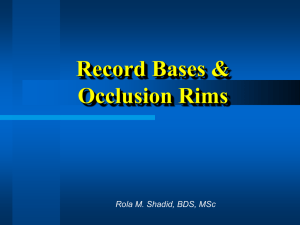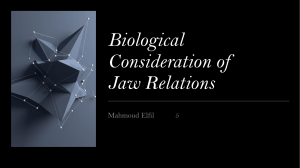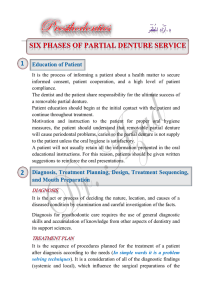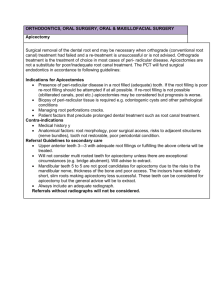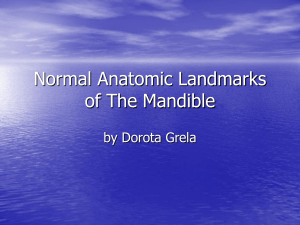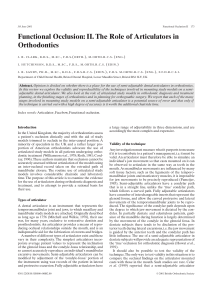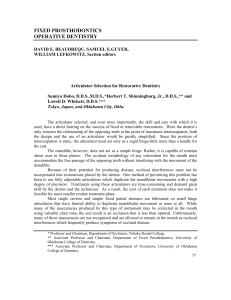Document 15341623
advertisement
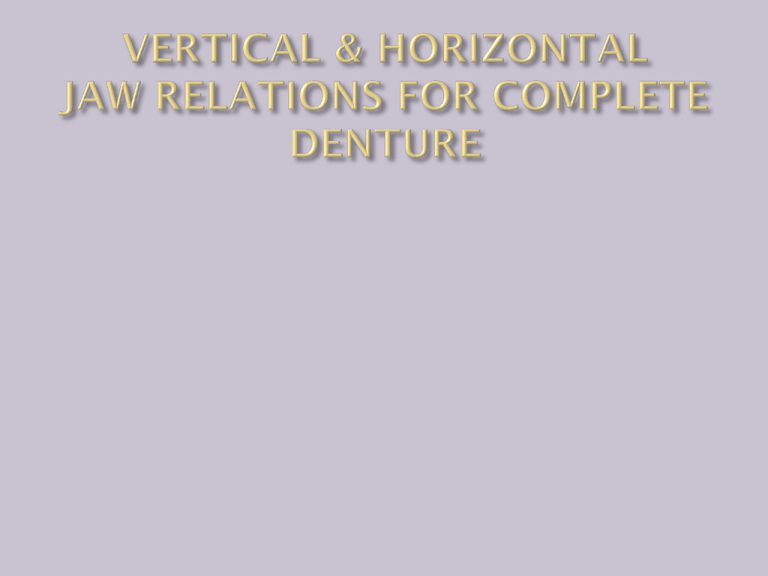
Three dimensions: Orientation relation Vertical relation Horizontal relation The facial height that exists between two arbitrarily selected points, one in the mandible & the other in the maxilla (Halperin) Or It is the distance between the two selected points, one on fixed & one on movable member (GPT 1999) Established by two things but under different conditions - mandibular musculature - Occlusal stops Vertical relation of rest. Vertical relation of occlusion. Physiologic Rest Position It is the vertical and horizontal position the mandible assumes when the mandibular musculature is relaxed and the patient is upright (Davenport) Or It is the mandibular position assumed when the head is in upright position and the involved muscles particularly the elevator & depressor groups are in equilibrium in tonic contraction & condyles are in a neutral unstrained position (GPT 1999) The face height that exists when the teeth are in occlusion (Halperin) Or It is the relation of the mandible to maxillae when occlusal stops are provided by teeth or occlusal rims (Boucher’s) The difference between the vertical relation of occlusion & the vertical relation of rest is the inter-occlusal space or freeway space. Constructing or assessing dentures The clinical procedure is to measure the rest vertical dimension & the occlusal vertical dimension & then calculate the freeway space. When the mandible is in the rest position & the teeth are out of contact there is no strain on the temporomandibular joint If new dentures have no freeway space If an excessive freeway space Short term variables Long term variables Variables dimension Patient supine Head tilted -Back -Forward Insertion of lower denture or record block Stress Pain Drugs Rest vertical Reduced Increased Increased Increased Reduced Reduced Variable Prosthetic treatment has an important long term influence on the rest position. It has been shown that an average 7 mm reduction in occlusal vertical dimension. The position of the mandible Patient should be calm, cool and relaxed when the jaw relations are recorded. Rest position is a position in space not to be maintained for definite period of time. Advisable to use several methods and compare the results The methods for determining the vertical relation can be grouped into two categories: Mechanical Methods Physiologic Methods Mechanical methods: 1) i. ii. iii. Ridge relation: a) distance of incisive papilla from mandibular incisors b) parallelism of ridges Measurement of former dentures Pre-extraction records Profile radiographs Profile photographs Casts of teeth in occlusion Facial measurements 2) Physiologic methods Physiologic rest position Phonetics & esthetics as guide Swallowing threshold Tactile sense Ridge relation: Incisive papilla – stable landmark Paralleling of max. & mandibular ridges plus 5 degree opening. Clinical crowns of anterior & posterior teeth- same length Disadvantage: absence of lower anterior teeth – cannot be used Dentures –measured---correlated ---patient’s face. Measurements - b/w borders of maxillary & mandibular denture------Boley gauge. PRE – EXTRACTION RECORDS: 1) profile radiograph Disadv: exposure to radiation & time consuming 2)Profile photographs disadv: angulation of photograph enlargement 3)casts of teeth articulated in occlusion Proportional measurement Lower border of septum of nose – lower border of chin = outer canthus of eye – corner of mouth. CENTRIC OCCLUSAL LINE Measured before loss of the remaining natural teeth Draw centric occlusal line on lower anterior teeth at horizontal level of Incisal edge of opposing upper anterior teeth. Sibiliant sounds – s, z, sh, zh, fish, church, judge Closest speaking space– measurement for vertical dimension CLOSEST SPEAKING LINE Methods for determining physiologic rest position Swallow & relax Fatigue Use of phonetics – M sound Electromyography Myomonitor TENS missipi Electromyography demonstrate their activation potential visual & audio signs– mandibular position TENS Niswonger’s method: (1934) Two marks interocclusal distance : 2-4mm at first premolar region. Base of nose Chin Disadvantages; Marks on skin – move –difficult – constant measurement. Lack of permanent reference points. Tactile methods 1)patient’s tactile sense as a guide 2)Lytle method 3)Boos biometer gnathodynamometer 4)Swallowing threshold Central bearing device attached to record bases Central bearing screws – palate of max. denture base/occlusal rim Central bearing plate- mand. Patient participation – very important. Disadvantage: Can’t be used in very sensible patients & impaired neuromuscular patients. Patients tended to register a reduced vertical dimension. Relied on pt’ muscular perception. Swallowing threshold Theory: swallows – teeth come together – very light contact A cone of soft wax on lower denture basecontact upper occlusal rims - Jaw too wide open Flow of saliva - stimulated 1) 2) 3) 4) 5) 6) 7) 8) 9) 10) Increased risk of traumaclenching of teeth. Discomfort to patient Teeth are liable to contact – causing clicking during speech Trauma & pain – basal seat areas of denture Loss of freeway space- muscular fatigue Clicking sound Elongated appearance of face Bone resorption Loss of retension & stability of dentures Generalised hyperemia. 1) 2) 3) 4) 5) 6) 7) 8) Reduced masticatory efficiency Poor esthetics Cheek biting/ tongue biting/ lip biting Denture look Angular chelitis Pain in TMJ Coston’s syndrome prognathism Judgement of facial support Visual observation of space b/w rims Observation – sibiliant words. Eccentric relation Centric relation Protrusive record Centric relation: -- GPT -8 Centric relation is defined as a maxillomandibular relationship in which the condyles articulate with the thinnest avascular portion of their respective disks with the complex in the anterior superior position against the shapes of articular eminences. This position is independent of tooth contact. This position is discernible when mandible is directed superiorly and anteriorly and restricted to a purely rotatary movement about a transverse horizontal axis. Lateral record Boucher's : A) static methodsInterocclusal record Central bearing device Tracing devices B)functional methods—chew –in technique Needles technique House technique Essig technique Patterson technique Causes minimal displacement of recording bases Intraoral interocclusal records- without central bearing point –using plaster/wax. Place 3 widely separated lines between the rims in the centric position CRITICAL! Check that record base heels/rims do not touch Eliminate contact with record bases Max & Mand Occusion Rims Two sharp “V”-shaped notches in the molar/premolar area of each sided wax Depth 1-2 mm 1-2 mm Too Shallow - no undercuts Rehearse making the record without recording medium Place occlusion rims intraorally PVS registration material (Memoreg) over entire occlusal rim Too Thick Good Want flat record, no excess on sides of rims Excess material recording of the sides of the rim can cause deflection when checking record Have patient close into record Ensure smooth arc of closure, no horizontal deviations Use index fingers to stabilize lower record base Patient opens, relaxes, and slowly closes • • Gently arc the mandible in a hinge-like motion There should be: •No translation •No splinting Patient slowly closes Operator uses tactile senses to ensure the mandible does not translate Patient closes until rims are almost touching (1 mm separation) Ask patient to stop as soon as this position has been reached Some may not be able to tell when they contact Never instruct the patient to bite firmly Causes translation or inaccuracy in the record Hold position until set 1-2 min Remove both rims together Separate Ensure record is repeatable Increase the height of incisal pin 1 mm, invert articulator Place wax rims together, lute with sticky wax - 4 spots Mixture of ½ plaster + ½ carborundum paste. mandibular movements-Compensating curves Disadvantages: time consuming. Graphic methods: Intra oral tracing & devices– Extra oral tracing & devices Advantages: Central bearing pins resists biting pressure Disadvantages: Not a visible method Difficult to find true apex Tracer- definitely seated in a hole at point of the apex Always combined with an intraoral bearing pointdistribute equal pressure on the bases. More sharper Tracing plate- mounted on mandibular rim Adv: Larger- apex-easily demarcated Visible during tracing Disadvantage: Lack of equal pressure on the ridges Is the ideal arch to arch relationship and an optimum functional position of jaws for the health, comfort and function of the TMJ and musculature. Is a hinge position. In CR condyles exhibit only pure rotation without any translation. Mandibular movements return or terminate in centric It is thus, a reproducible position and therefore serves as a reliable reference to develop occlusion in complete dentures. Prosthodontic treatment foe edentulous patients- zarb-bolender 12th edn. 57 It is a position where upper and lower teeth are braced against each other during deglutition. Serves as a reference position for occlusal reconstruction in dentulous situations. It is a posterior border position and the posterior limit of the envelope of mandibular motion. Prosthodontic treatment foe edentulous patients- zarb-bolender 12th edn. 58 Protrusive relation record Lateral relation record Methods for recording eccentric jaw relation Functional method- needles- house & patterson technique Graphic method Tactile / direct check record methods Christensen’s phenomenon Due to downward displacement of the condlyes along the articular slope. Protrusive records are made ofDirect protrusive check record Graphic method Functional procedures Common methods: Graphic method With check bites of wax With positional records of stone/plaster Pantography Hanau’s formula: L = H/8 + 12 L=lateral condylar inclination H=Horizontal condylar inclination Method for recording centric relation Procedure: position the chair-lie back flat Strech the neck by pointing the chin up Fore fingers –both hands-lower border of mandible Little finger-angle of mandible Thumbs-into notch above symphysis Condyle is forced upward & backward Condyle –uppermost position-jaw hinge freely. Other methods 1) Celluloid strip method 2) Softened wax method 3) Deep heating/ pooling method Natural dentition– damage to periodontal structure, hypersensitivity, excessive attrition, hypermobility of teeth. Pain & dysfunction of masticatory muscle, headache, neck& shoulder pain. Dentures- not in centric relation— premature contact. TMJ dysfunction— condyle press upon peripheral vascular & innervated part of articular disc. Mucosal irritation & soreness. Spasm of muscle of mastication Resorption of residual alveolar ridges.
